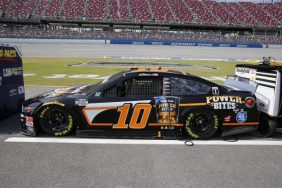Unlike most other sports, NASCAR kicks off the season with its biggest event, a race that proves to be both the most important and the most prestigious: the Daytona 500. Viewed on more televisions throughout the United States than any other auto race, ensuring the Daytona 500 goes off without a hitch is an incredible undertaking, one that’s evolved greatly since its inception in 1959.
But it’s not just Daytona that gets such elaborate attention. Each NASCAR race is handled with the same amount of attention to detail, whether it’s on the track or in the pit. To put on a race at tracks such as Talladega Superspeedway and Pocono Raceway requires basically a small city, which is seemingly constructed over the course of several dozen hours. Haulers are set up throughout the infield, each focused on different variables of race production – and each are of equal importance.
The officiating hauler has revolutionized NASCAR and greatly enhanced the product. Less than a decade ago, 43 people were necessary in race control, with each one designated to a specific car.
“The idea was that we have 43 officials standing out on pit road and their biggest responsibility was to not get killed,” said George Grippo, Managing Director of Competition Technology. “You’ve got a car coming at you at sometimes 100 mph, so we felt that was really unsafe and we started thinking about how we could get those guys on the cold side of the wall and we came up with, if we can have cameras up on the roof – or somewhere – and track the [drivers], we can get [officials] out of harm’s way.”

Since the officials had to worry as much about their safety as monitoring the action on the track, it limited their abilities to oversee the race and make certain drivers were following NASCAR’s guidelines. That all changed around 2010, when it was clear there was a better – and much safer – alternative to officiating races. The folks at NASCAR reached out to industry leaders in technology and one company, known for overseeing technology involved with the officiating of professional tennis, proved to be a perfect fit, allowing officials to ditch the fire suits and move into an air conditioned trailer.
“A company called Hawk-Eye, which does the ball bouncing in and out, came back and said, ‘We can track cars, we’ll tie-into a timing and scoring system – as the car comes down, we’ll pick it up on cameras and we’ll be able to officiate 90-percent of the race from the safety of the truck,” Grippo added.
But with all of the tracks at least a half mile, many cameras are necessary, especially in the pit.
Prior to each race, Dusty Dwyer, NASCAR’s Senior Pit Road Officiating Technician, and his team measure the lines in pit row using a laser for precision. From there, Dwyer is able to use extensive trigonometry to create a three dimensional model that allows for pinpoint accuracy when setting up the nearly 50 cameras used for monitoring the area. It takes three people about 10 hours to place the cameras in their appropriate position and then another three hours to calibrate the equipment. Add in three hours for image stabilization and it’s about a 12 to 15 hour process in total – every single week.
With cameras that can see everything and an automatic system that has the ability to enforce infractions for driving through three or more pit boxes and pitting outside of the box, the need for so many officials was unnecessary, so NASCAR trimmed it to eight. NASCAR’s setup makes it incredibly difficult for an infraction to fly under the radar – but that doesn’t stop teams looking for an edge.

“[Teams] are obviously always working to try to bend those rules to get around it, so you’ll find that [teams] wearing very dark clothes will jump into the shadows – they’ll try and trick the cameras,” Dwyer said during the Championship Weekend in Miami last December. “We have to make sure that the eight officials in here are able to view it so they can confirm whether or not it was an infraction.”
Such an elaborate system of officiating brings a level of consistency to the sport, one that was often missing in the past. NASCAR’s system can be likened to a call center, in that no official has the ability to look at any particular car or any particular pit box, it’s done completely at random. An official might see the No. 48 car once over the course of a race, or see it 10 times, or not at all. There’s such a level of sophistication that the system is capable of finding an infraction during pit stops and if all eight officials are occupied, it’ll then prioritize it and queue it for the next available person – and, as Dwyer indicated, a vehicle infraction goes right to the top of the list, because it carries the most severe penalty.
So how effective is the new system compared with how NASCAR previously officiated races?
“When we first ran the system in 2014, when we were testing it, we went to Talladega in the fall and we still had the 43 officials out on pit road and we ran this system as well,” Dwyer explained. “After the race was finished, the 43 officials caught three penalties the entire race but this system caught 177 penalties – so the teams were cheating a lot. And the teams actually gave us great feedback.”
Ed Miller is a contributor for CraveOnline Sports, a movie quote extraordinaire and a proud Sun Devil. You can follow him on Twitter @PhillyEdMiller or “like” CraveOnline Sports on Facebook.
Photo: Getty






